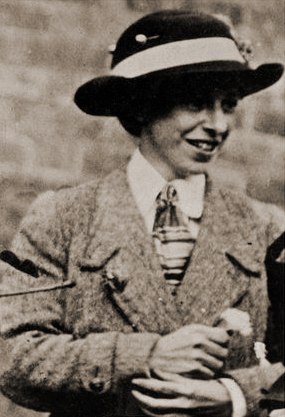Mary Richardson
Mary Richardson was a Suffragette remembered for her militant methods of protest in the fight for women’s rights. She found fame when she vandalised a painting by Velazquez at the National Gallery in London. She was sentenced to prison numerous times, but remained dedicated to the suffragist cause.
Mary Raleigh Richardson was born in Ontario, Canada in 1882, before moving to London where she became involved in the British Suffragette movement.
Mary Richardson joined the Women’s Social and Political Union (WSPU) in 1910. This organisation was founded and run by Emmeline Pankhurst and her daughters. She joined the other members of the WSPU in turning to militancy to advance the cause, as more peaceful activism seemed to be having little effect.

Mary Richardson believed that militancy should be used to advance the cause of the Suffragette Movement. In fact, she was arrested nine times for her militant protests, which included breaking windows and assaulting police officers. She continued her protests in prison, going on hunger strike and eventually being force fed.
One of the most infamous incidents of activism was when she jumped onto the running board of King George V’s carriage as it was passing through the street. She then thrust a Suffragette petition into his hands.
Her most famous act of defiance occurred on 10 March 1914 when she entered the National Gallery in London and slashed the Rokeby Venus by DIego Velazquez with a meat cleaver. She later described the event, explaining that she took hours to pluck up the courage to attack the painting with an axe. Eventually she delivered half a dozen blows with the axe before she was arrested.
Richardson was immediately arrested at the gallery and sent to Holloway.
The Suffragettes put a stop to their protest at the outbreak of war in 1914, when Emmeline Pankhurst encouraged women to get involved in the war effort.
In 1918 the Representation of the Peoples Act was introduced, giving women over the age of 30 with property the right to vote. This went some way to giving the Suffragettes what they wanted, but it was not until 1928 that full equality was introduced.
Richardson joined the Labour Party in 1919. She stood for Parliamentary election four times over the next decade. The first occasion was in November 1922 when she stood as Labour candidate in Acton, Middlesex, receiving 26.2 per cent of the vote against the successful Conservative candidate. In October 1924 she stood for the same seat as an independent socialist against the official Labour candidate and obtained 7.6 per cent of the vote. Although adopted as a prospective parliamentary candidate for the rural constituency of Bury St Edmunds in 1926, she did not stand in the 1929 election. In 1931 she was adopted as a last-minute Labour candidate in Aldershot against Lord Wolmer, the National Government incumbent, and lost heavily.
Probably frustrated with mainstream parties, Mary Richardson then turned to supporting the British Union of Fascists led by Oswald Moseley. Richardson joined in 1934 and became head of the women’s section. However, she left the BUF in 1935 and turned her back on politics.
Mary Richardson moved to Hastings, East Sussex, and in 1953, she wrote her autobiography, “Laugh at Defiance”.
Mary Richardson died on 7 November 1961.
See also: Force-feeding of Suffragettes
MLA Citation/Reference
"Mary Richardson". HistoryLearning.com. 2025. Web.
Key facts
| Name: | Mary Richardson |
| Birth Date: | 1882/3 |
| Death: | 7 November 1961 |
| Occupation: | Journalist, Activist |
| Known for: | Slashing the Rokeby Venus |
